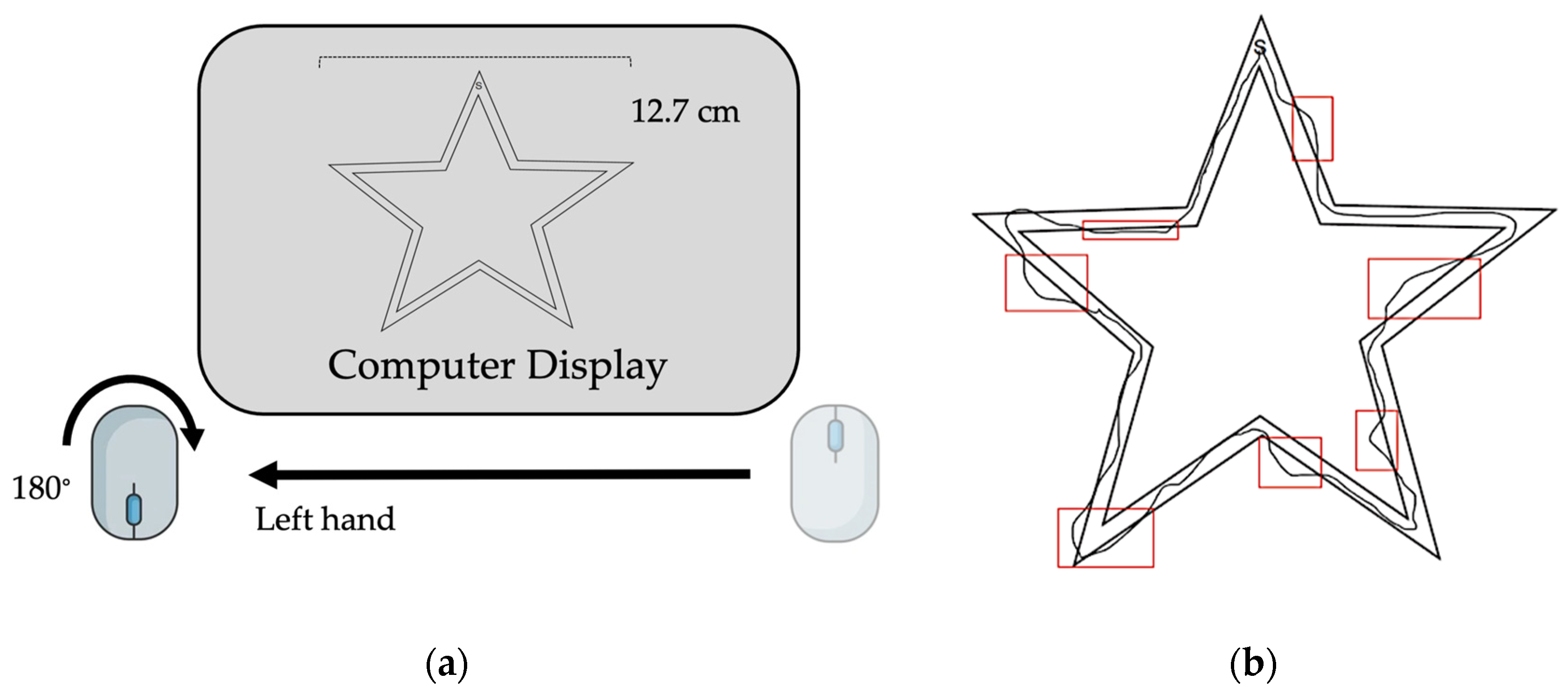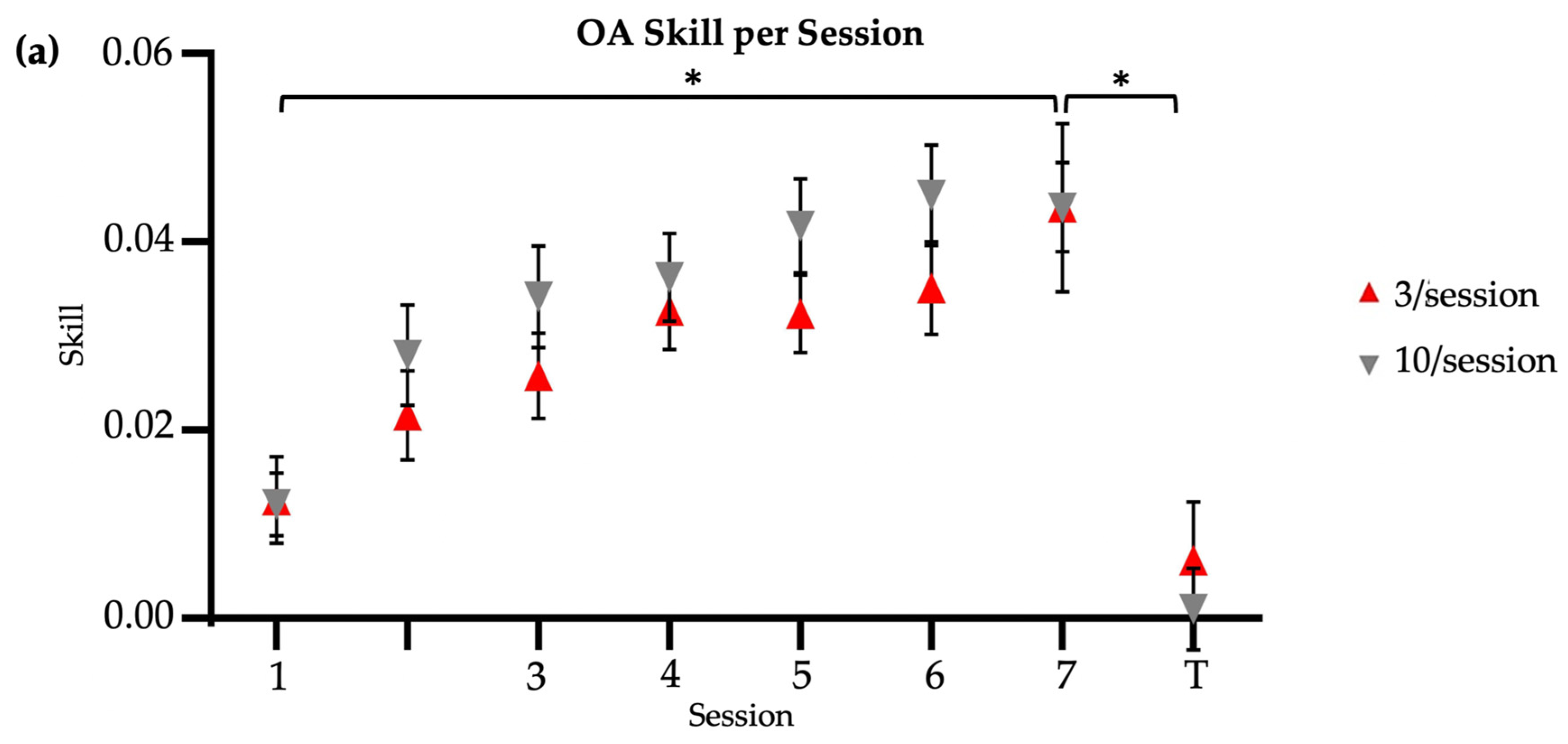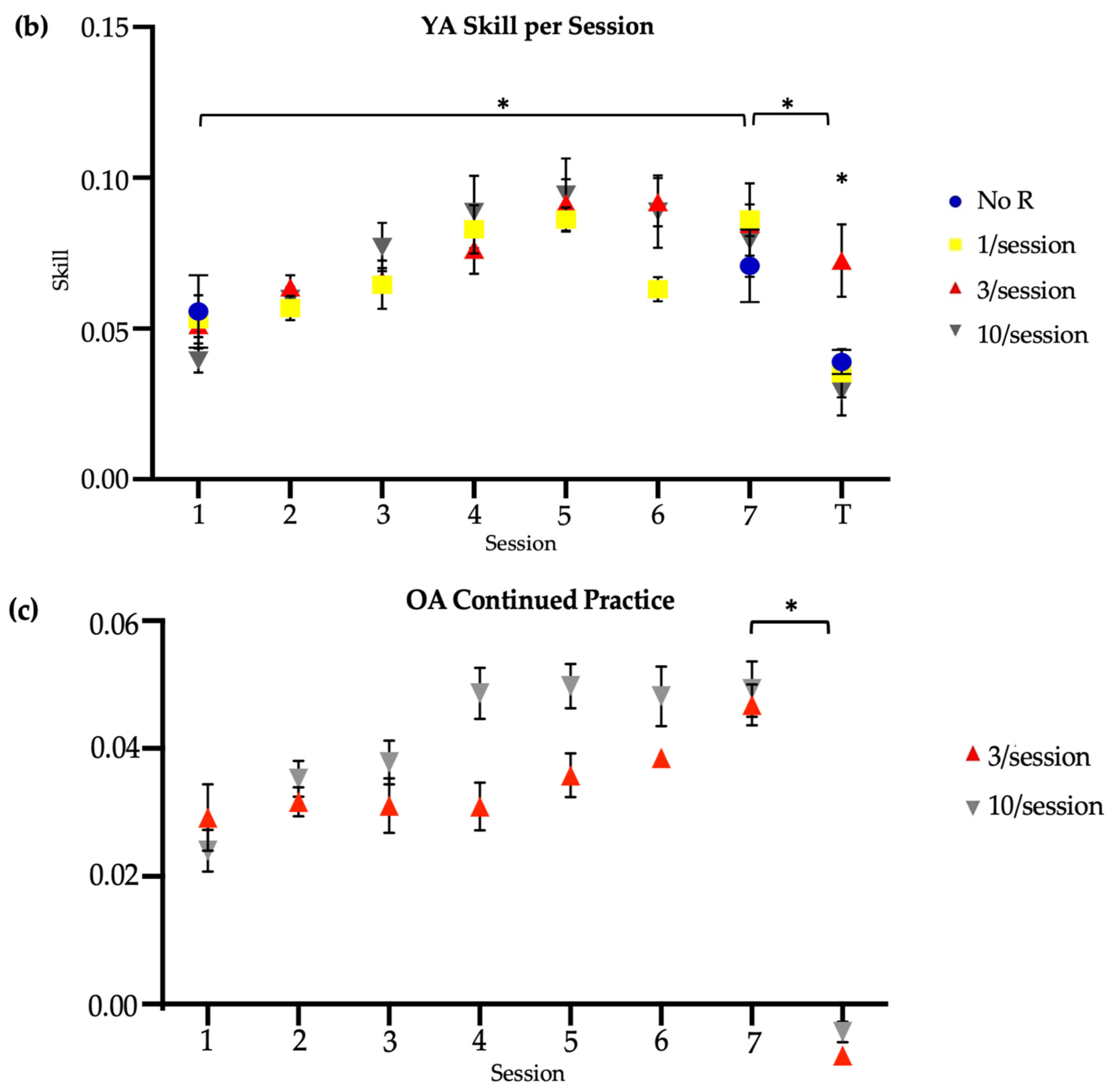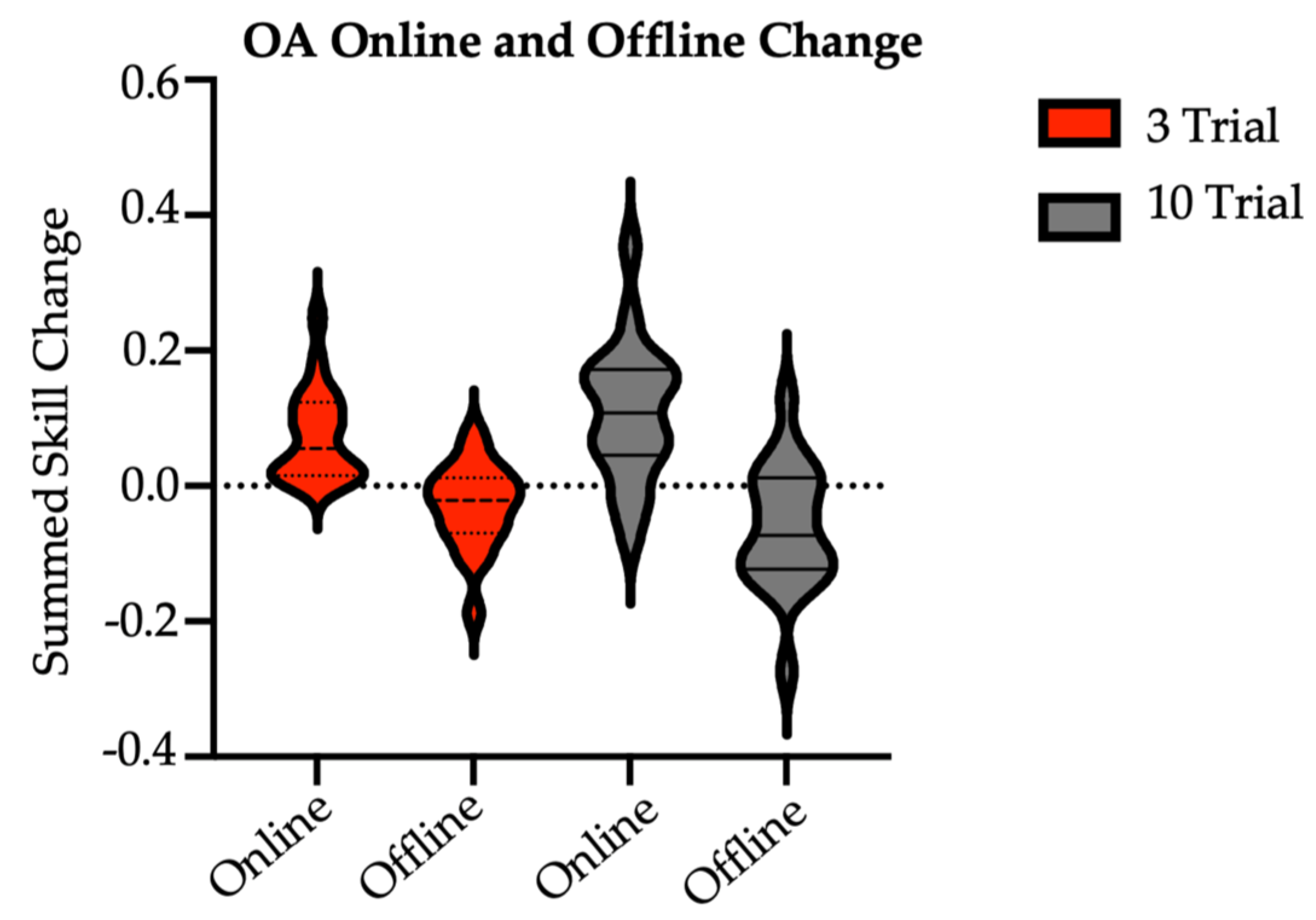Age-Related Differences in Motor Skill Transfer with Brief Memory Reactivation
Abstract
1. Introduction
2. Materials and Methods
2.1. Motor Task
2.2. Outcomes
3. Results
3.1. Healthy Older Adults
3.2. Age-Related Differences
3.3. Older Adults’ Continued Practice
4. Discussion
5. Conclusions
Author Contributions
Funding
Institutional Review Board Statement
Informed Consent Statement
Data Availability Statement
Conflicts of Interest
References
- MuÈller, G.E.; Pilzecker, A. Experimentelle Beitrage zur Lehre vom Gedachtnis. Z. Psychol. 1900, (Suppl. S1). Available online: http://hdl.handle.net/2027/coo.31924076334089 (accessed on 4 September 2023).
- Atkinson, R.C.; Shiffrin, R.M. Human Memory: A Proposed System and its Control Processes. Psychol. Learn. Motiv. 1968, 2, 89–195. [Google Scholar] [CrossRef]
- McGaugh, J.L. Memory-A Century of Consolidation. Science 2000, 287, 248–251. [Google Scholar] [CrossRef] [PubMed]
- Misanin, J.R.; Miller, R.R.; Lewis, D.J. Retrograde amnesia produced by electroconvulsive shock after reactivation of a consolidated memory trace. Science 1968, 160, 203–204. [Google Scholar] [CrossRef] [PubMed]
- Nader, K.; Schafe, G.E.; Le Doux, J.E. Fear memories require protein synthesis in the amygdala for reconsolidation after retrieva. Nature 2000, 406, 722–726. [Google Scholar] [CrossRef] [PubMed]
- Walker, M.P.; Brakefield, T.; Hobson, J.A.; Stickgold, R. Dissociable stages of human memory consolidation and reconsolidation. Nature 2003, 425, 616–620. [Google Scholar] [CrossRef]
- Wymbs, N.F.; Bastian, A.J.; Celnik, P.A. Motor skills are strengthened through re-consolidation. Curr. Biol. 2016, 26, 338–343. [Google Scholar]
- Kimberley, T.J.; Samargia, S.; Moore, L.G.; Shakya, J.K.; Lang, C.E. Comparison of amounts and types of practice during rehabilitation for traumatic brain injury and stroke. J. Rehabil. Res. Dev. 2010, 47, 851–861. [Google Scholar] [CrossRef]
- Lang, C.E.; MacDonald, J.R.; Gnip, C. Counting repetitions: An observational study of outpatient therapy for people with hemiparesis post-stroke. J. Neurol. Phys. Ther. 2007, 31, 3–10. [Google Scholar] [CrossRef]
- Pedreira, M.E.; Pérez-Cuesta, L.M.; Maldonado, H. Mismatch between what is expected and what actually occurs triggers memory reconsolidation or extinction. Learn. Mem. 2004, 11, 579–585. [Google Scholar] [CrossRef]
- Johnson, B.P.; Cohen, L.G.; Westlake, K.P. The Intersection of Offline Learning and Rehabilitation; Frontiers Media S.A.: Lausanne, Switzerland, 2021. [Google Scholar] [CrossRef]
- de Beukelaar, T.T.; Woolley, D.G.; Wenderoth, N. Gone for 60 seconds: Reactivation length determines motor memory degradation during reconsolidation. Cortex 2014, 59, 138–145. [Google Scholar] [CrossRef]
- Herszage, J.; Sharon, H.; Censor, N. Reactivation-induced motor skill learning. Proc. Natl. Acad. Sci. USA 2021, 118, e2102242118. [Google Scholar] [CrossRef] [PubMed]
- Johnson, B.; Tomlin, K.B.; Censor, N.; Cohen, L.G.; Westlake, K.P. Motor Memory Reactivation: Brief Practice Makes Perfect. 2022. Available online: https://osf.io/preprints/psyarxiv/q5y9n (accessed on 7 August 2023).
- Gui, W.-J.; Li, H.-J.; Guo, Y.-H.; Peng, P.; Lei, X.; Yu, J. Age-related differences in sleep-based memory consolidation: A meta-analysis. Neuropsychologia 2017, 97, 46–55. [Google Scholar] [CrossRef] [PubMed]
- Harand, C.; Bertran, F.; Doidy, F.; Guénolé, F.; Desgranges, B.; Eustache, F.; Rauchs, G. How aging affects sleep-dependent memory consolidation? Front. Neurol. 2012, 3, 8. [Google Scholar] [CrossRef] [PubMed]
- Buckley, T.M.; Schatzberg, A.F. Aging and the Role of the HPA Axis and Rhythm in Sleep and Memory-Consolidation. Am. J. Geriatr. Psychiatry 2005, 13, 344–352. [Google Scholar] [CrossRef] [PubMed]
- Yan, J.H.; Abernethy, B.; Xiaojian, L. The effects of ageing and cognitive impairment on on-line and off-line motor learning. Appl. Cogn. Psychol. 2010, 24, 200–212. [Google Scholar] [CrossRef]
- Bootsma, J.M.; Caljouw, S.R.; Veldman, M.P.; Maurits, N.M.; Rothwell, J.C.; Hortobágyi, T. Neural Correlates of Motor Skill Learning Are Dependent on Both Age and Task Difficulty. Front. Aging Neurosci. 2021, 13, 643132. [Google Scholar] [CrossRef] [PubMed]
- Berghuis, K.M.M.; Fagioli, S.; Maurits, N.M.; Zijdewind, I.; Marsman, J.B.C.; Hortobágyi, T.; Koch, G.; Bozzali, M. Age-related changes in brain deactivation but not in activation after motor learning. NeuroImage 2019, 186, 358–368. [Google Scholar] [CrossRef]
- Oldfield, R.C. The assessment and analysis of handedness: The Edinburgh inventory. Neuropsychologia 1971, 9, 97–113. [Google Scholar] [CrossRef]
- Morley, J.E.; Tumosa, N. Saint Louis University Mental Status Examination (SLUMS); [Database record]; APA PsycTests: Amsterdam, The Netherlands, 2002. [Google Scholar]
- Tombaugh, T.N.; McDowell, I.; Kristjansson, B.; Hubley, A.M. Mini-Mental State Examination (MMSE) and the Modified MMSE (3MS): A psychometric comparison and normative data. Psychol. Assess. 1996, 8, 48–59. [Google Scholar] [CrossRef]
- Reis, J.; Schambra, H.M.; Cohen, L.G.; Buch, E.R.; Fritsch, B.; Zarahn, E.; Celnik, P.A.; Krakauer, J.W. Noninvasive cortical stimulation enhances motor skill acquisition over multiple days through an effect on consolidation. Proc. Natl. Acad. Sci. USA 2009, 106, 1590–1595. [Google Scholar] [CrossRef]
- Anshel, M.H. Effect of aging on acquisition and short-term retention of a motor skill. Percept. Mot. Skills 1978, 47, 993–994. [Google Scholar] [CrossRef] [PubMed]
- Reuter-Lorenz, P.A.; Cappell, K.A. Neurocognitive aging and the compensation hypothesis. Curr. Dir. Psychol. Sci. 2008, 17, 177–182. [Google Scholar] [CrossRef]
- Hegele, M.; Heuer, H. Age-related variations of visuomotor adaptation result from both the acquisition and the application of explicit knowledge. Psychol. Aging 2013, 28, 333–339. [Google Scholar] [CrossRef] [PubMed]
- Hooyman, A.; Wang, P.; Schaefer, S.Y. Age-related differences in functional tool-use are due to changes in movement quality and not simply motor slowing. Exp. Brain Res. 2021, 239, 1617–1626. [Google Scholar] [CrossRef]
- Vieluf, S.; Godde, B.; Reuter, E.-M.; Voelcker-Rehage, C. Age-related differences in finger force control are characterized by reduced force production. Exp. Brain Res. 2013, 224, 107–117. [Google Scholar] [CrossRef]





| 3 Trials/Session | 10 Trials/Session | |
|---|---|---|
| n | 20 | 20 |
| Age (M yrs.) | 71.7 | 72.1 |
| Sex | 17f/3m | 12f/8m |
| SLUMS 1 | 27.9 | 28.1 |
| MMSE 2 | 29.2 | 29.1 |
| Session | 1 | 2 | 3 | 4 | 5 | 6 | 7 | |
|---|---|---|---|---|---|---|---|---|
| Retention | Transfer | |||||||
| Trials | Trials | Trials | Trials | Trials | Trials | Trials | Trials | |
| 3/session | 9 | 3 | 3 | 3 | 3 | 3 | 3 | 3 |
| 10/session | 9 | 10 | 10 | 10 | 10 | 10 | 3 | 3 |
Disclaimer/Publisher’s Note: The statements, opinions and data contained in all publications are solely those of the individual author(s) and contributor(s) and not of MDPI and/or the editor(s). MDPI and/or the editor(s) disclaim responsibility for any injury to people or property resulting from any ideas, methods, instructions or products referred to in the content. |
© 2024 by the authors. Licensee MDPI, Basel, Switzerland. This article is an open access article distributed under the terms and conditions of the Creative Commons Attribution (CC BY) license (https://creativecommons.org/licenses/by/4.0/).
Share and Cite
Tomlin, K.B.; Johnson, B.P.; Westlake, K.P. Age-Related Differences in Motor Skill Transfer with Brief Memory Reactivation. Brain Sci. 2024, 14, 65. https://doi.org/10.3390/brainsci14010065
Tomlin KB, Johnson BP, Westlake KP. Age-Related Differences in Motor Skill Transfer with Brief Memory Reactivation. Brain Sciences. 2024; 14(1):65. https://doi.org/10.3390/brainsci14010065
Chicago/Turabian StyleTomlin, Kylie B., Brian P. Johnson, and Kelly P. Westlake. 2024. "Age-Related Differences in Motor Skill Transfer with Brief Memory Reactivation" Brain Sciences 14, no. 1: 65. https://doi.org/10.3390/brainsci14010065
APA StyleTomlin, K. B., Johnson, B. P., & Westlake, K. P. (2024). Age-Related Differences in Motor Skill Transfer with Brief Memory Reactivation. Brain Sciences, 14(1), 65. https://doi.org/10.3390/brainsci14010065





